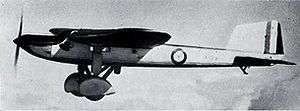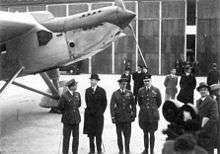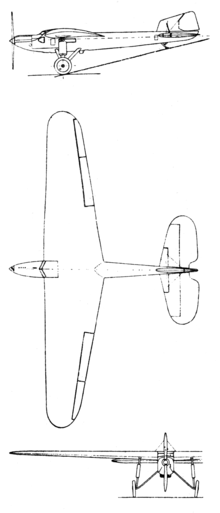Fairey Long-range Monoplane
The Fairey Long-range Monoplanes was a British experimental aircraft first flown in 1928. It was single-engine, high-wing aircraft with fixed tail skid landing gear. Two examples were built.
| Long-range Monoplane | |
|---|---|
 | |
| K1991 the World's Long Distance Record aircraft | |
| Role | experimental aircraft |
| National origin | United Kingdom |
| Manufacturer | Fairey Aviation |
| First flight | 14 November 1928 |
| Primary user | Royal Air Force |
| Number built | 2 |
Design and development
The aircraft was designed to meet Air Ministry Specification 33/27, issued by the Directorate of Technical Development (DTD) in December 1927 after the failure of three attempts by the RAF to break the absolute distance world record flying Hawker Horsley bombers.[1] According to a Ministry spokesman in the House of Commons, this aircraft was to be constructed not just "for a specific record," but as a serious study into methods of increasing the range of aircraft. In order to soothe the anxieties of the Treasury, the aircraft started life as the Postal Aircraft.[2] The pointed nose and sleek lines of the prototype gave rise to the nickname "Eversharp," after the maker of pens and mechanical pencils.[3]
Although other configurations were studied, after wind tunnel testing a high wing was chosen, allowing a gravity feed from the fuel tanks. The wing's spars were of wood with a steel pyramid system of internal bracing intended to add torsional rigidity and ensure that flight loads were evenly distributed between the spars irrespective of the position of the centre of pressure, and were fabric covered. The fuel capacity was 1,043 Imp gals (4,742 L) and the system used a gravity feed and mechanical fuel pump in sequence; a wind-driven, emergency back-up pump was also provided. There were other features dedicated to the long-range function; there were two parallel oil filter circuits, allowing one filter to be removed and cleaned while the other remained in operation. The aircraft was even equipped with a pneumatic bed for a reserve pilot. After extensive testing using a Fairey IIIF and a DH.9A, the Napier Lion XIA of 570 hp (430 kW) was selected late in the design process.
Operational history
The first built, J9479, flew for the first time on 14 November 1928 from RAF Northolt.[4] The aircraft was handed over to the RAF on 7 December, and testing continued in preparation for the record attempt, including a 24-hour trial on 22–23 March 1929. It was decided to attempt a flight to Bangalore in India, a great-circle distance of about 5,000 mile (8,000 km), comfortably in excess of the existing record of 4,466 miles (7,188 km) set by a Savoia-Marchetti S.64 in July 1928.[4] Squadron Leader A. G. Jones-Williams and Flight Lieutenant N. H. Jenkins set off from RAF Cranwell, Lincolnshire on 24 April 1929. The aircraft was slowed by headwinds, and they landed at Karachi after 50 hours 48 minutes in the air.[5] Although the flight was the first non-stop flight between Britain and India, the great circle distance of 4,130 miles (6,646 km) was short of the world records.[6] It was decided to make another record attempt later that year, although the record had been raised to 4,912 miles (8,007 km) by the Breguet 19 Point d'Interrogation. This time it was planned to fly from England to South Africa. This second attempt, with the same crew as the first, took off on 16 December 1929, but crashed south of Tunis, destroying the aircraft and killing the crew.[7] The navigation log was recovered from the crash site; according to this the aircraft's altitude at 18:00 was 5,000 feet (1,500 metres). However, the barographs with which the aircraft was fitted recorded an altitude of less than 3,000 feet (910 metres) at this time. The impact point was 2,300 feet (700 metres) above sea level. Two possible causes are that the log entry was erroneous and that the aircraft had, due to the poor weather, descended and that the difference in barometric pressure between Tunisia and Cranwell had caused them to believe that their altitude was greater than was the case; an alternative explanation is simply that the altimeter had failed.[8]
Despite this setback, the Air Ministry ordered a second Long-range Monoplane (K1991) in July 1930, this flying on 30 June 1931. While similar to the first aircraft, it had a number of differences, including the addition of an autopilot and wheel spats.[9][10]

On 27–28 October 1931 Squadron Leader O. R. Gayford (the officer in charge of the RAF Long Range Development Unit) and Flight Lieutenant D. Betts as navigator flew K1991 from RAF Cranwell to Abu Seir in Egypt. The 2,557 miles (4,115 km) was completed in 31½ hours.[11]
From 6–8 February 1933, Gayford and his navigator Flight Lieutenant G. E. Nicholetts flew non-stop in the second aircraft, K1991, from Cranwell to Walvis Bay, South West Africa. This was a world long-distance record of 5,410 mi (8,540 km). On their return to RAE Farnborough they were met by the Air Minister (Lord Londonderry), Under Secretary for Air (Sir Philip Sassoon) and Sir John Salmond, Marshal of the Royal Air Force.[12]
The distance record stood until August 1933 when it was taken back by the French.[11] Gayford and the LRDU would later make long-distance flights with the Vickers Wellesley.
After K1991 flew back to the United Kingdom a number of suggestions to re-engine the aircraft were made and the Air Ministry issued Specification 27/33 for it to be re-engined with a Jumo engine; the aircraft was reconditioned but it was decided to design a new aircraft instead.[13] Not needed, K1991 was scrapped.
Specifications (Fairey Long-range Monoplane II)

Data from Fairey Aircraft since 1915[2]
General characteristics
- Crew: 2
- Length: 48 ft 6 in (14.78 m)
- Wingspan: 82 ft 0 in (24.99 m)
- Height: 12 ft 0 in (3.66 m)
- Wing area: 850 sq ft (79 m2)
- Max takeoff weight: 17,500 lb (7,938 kg)
- Powerplant: 1 × Napier Lion XIa W-12 liquid-cooled piston engine, 570 hp (430 kW)
- Propellers: 2-bladed fixed-pitch propeller
Performance
- Cruise speed: 110 mph (180 km/h, 96 kn) [14]
- Wing loading: 20.7 lb/sq ft (101 kg/m2)
- Power/mass: 0.033 hp/lb (0.054 kW/kg)
- Take-off run: 4,500 ft (1,372 m)
See also
Aircraft of comparable role, configuration and era
Related lists
References
Notes
- Taylor 1977, p. 18.
- Taylor, H.A. (1974). Fairey Aircraft since 1915. London: Putnam. pp. 180–192. ISBN 0-370-00065X.
- Winchester 2005, p. 37.
- Taylor 1977, p. 19.
- Air Progress: 15. November 1978. Missing or empty
|title=(help) - Taylor 1977, pp. 19–20.
- Taylor 1977, pp. 20–21.
- Taylor 1974, p.187
- Taylor 1977, p. 21.
- Cooksley 1993, p. 52.
- Thetford 1976, p.246
- "Oswald Gayford - Hadliegh's World Record Breaker". Hadliegh.org.uk. Archived from the original on 2 January 2014. Retrieved 28 June 2020.
- Meekcoms/Morgan 1994, p.6
- Thetford 1957, pp. 208–209.
Bibliography
- Cooksley, Peter. "Long Range Fairey". Air Enthusiast, Fifty-one, August to October 1993.Stamford, UK:Key Publishing. ISSN 0143-5450. pp. 49–53.
- Meekcoms, K and Morgan, E. The British Aircraft Specification File. Tonbridge, Kent, England:Air-Britain Historians: 1994. ISBN 0 85130 220 3
- Taylor, H. A. "Record-breaker Extraordinary." Air International, Volume 13, No. 1, July 1977, pp. 18–24.
- Thetford, Owen. Aircraft of the Royal Air Force 1918–57. London:Putnam, 1957.
- Thetford, Owen. Aircraft of the Royal Air Force since 1918. London:Putnam: 1975. ISBN 0 370 10056 5
- Winchester, Jim. X-Planes and Prototypes. London: Amber Books Ltd., 2005. ISBN 1-904687-40-7.
External links
| Wikimedia Commons has media related to Fairey Long-range Monoplane. |
- "Bravo - Gayford! Bravo - Nicholetts! Bravo - The RAF! (1933)" on YouTube
- "Fairey Long Range Monoplane" on YouTube